Dear Bud & others,
I am NOT talking about doing the usual method(s) for the EnABle process, I am talking about exagerrating dramatically one or more of the parameters to make CLEAR the effect(s).
Parameters =
- size
- number
- mass
- material
- etc...
Things like that... use some lead strips for example, and SEE that the addition of significant small masses will have.
Use LARGE strips of high mass, and see what that does.
Clearly it will be excessive, but it will SHOW something CLEARLY about what mechanisms are being effected and what directions they go in...
Dunno, seems like an idea?
(I read a few pages back... that's not what I am suggesting in terms of tests)
I am NOT talking about doing the usual method(s) for the EnABle process, I am talking about exagerrating dramatically one or more of the parameters to make CLEAR the effect(s).
Parameters =
- size
- number
- mass
- material
- etc...
Things like that... use some lead strips for example, and SEE that the addition of significant small masses will have.
Use LARGE strips of high mass, and see what that does.
Clearly it will be excessive, but it will SHOW something CLEARLY about what mechanisms are being effected and what directions they go in...
Dunno, seems like an idea?
(I read a few pages back... that's not what I am suggesting in terms of tests)
Lots of (unfounded) assumptions in your proposal. Confounding could occur if the supposed effect is not mass related, or size related (or a combination of both), or if the positioning is highly sensitve... it's not simple to determine whether a cause/effect relationship exists here... hence the opposition to hand-waving "boundary layer" effects that remain unproven (or even clearly demonstrated)
John L.
John L.
For that to work one has to have the ability to adequately measure the parameter or determine it and provide proof in some manner. The concepts and effects hypothesized are not those which most have the capability to measure. That's the crux of the problem to begin with. If we could measure them, there would be no debate. I seriously doubt that anyone who frequents this board can measure the boundary layer or most other of the effects described, even less so that of a dynamic driver.Dear Bud & others,
I am NOT talking about doing the usual method(s) for the EnABle process, I am talking about exagerrating dramatically one or more of the parameters to make CLEAR the effect(s).
We can, however, easily measure parameters on which the change does have known impact, things such as T/S parameters, any and all derived responses from an impulse such as SPL, phase, step, etc., that would have to be taken on a polar basis. And if one cared to take the time, do a lengthy set of various distortion measurements. These are the effects that actually matter. Without these or some other valid set of measurements, anything postulated outside of these well-known effects is just making an unsubstantiated hypothesis. Subjective listening and hypothesizing is not proof of anything.
Google "boundary layer measurements". This link is from a Cal State wind tunnel test and is just one paper you might find. Consider the difficulty and required resources described in that one alone.
Simplistic testing won't prove anything.
Dave
Dave is certainly correct Bear, we just don't have easy access to the equipment required.
We do have some results from tests done on "extreme" pattern applications from the original thread,
http://www.diyaudio.com/forums/multi-way/100399-enabl-processes-26.html#post1227789 multiple rings and phase vs frequency response
http://www.diyaudio.com/forums/multi-way/100399-enabl-processes-28.html#post1231568 dispersal of "break up modes" and resonance nodes
http://www.diyaudio.com/forums/multi-way/100399-enabl-processes-226.html#post1427403 large blocks and dots applied
These may help you in refining your suggestions.
Bud
We do have some results from tests done on "extreme" pattern applications from the original thread,
http://www.diyaudio.com/forums/multi-way/100399-enabl-processes-26.html#post1227789 multiple rings and phase vs frequency response
http://www.diyaudio.com/forums/multi-way/100399-enabl-processes-28.html#post1231568 dispersal of "break up modes" and resonance nodes
http://www.diyaudio.com/forums/multi-way/100399-enabl-processes-226.html#post1427403 large blocks and dots applied
These may help you in refining your suggestions.
Bud
I'm not sure if I understand what Bear is getting at. Added mass is pretty well understood and just about anyone with a Woofer Tester uses added mass as a matter of procedure when measuring. I know that years ago, on the old "Bass List" there were experiments of this nature. I believe that there were some alterations in the "Q" of the DUT, but not much else that remotely resembles what Bud has related pertaining to the EnAble method.
Best Regards,
TerryO
Best Regards,
TerryO
Terry,
yeah.
Added mass is usually at the center near the VC and behind the dustcap... not out on the "rings of saturn".
John L. I agree. Not so simple or easy. First pass is to rule in or out very simple effects...
Bud, I will try to take some time to look at the links you put up...
Fwiw, there was a speaker "back in the day" by University that had a mechanical xover built into the cone. I guess it was some sort of compliance ring, I am not clear on it actually, but I suppose it could move a bit at HF and not much at LF, so the woofer worked out the edge at LF. Not sure, but they did do this sort of thing... it seems conceptually related, even if removed by some degree...
_-_-bear
yeah.
Added mass is usually at the center near the VC and behind the dustcap... not out on the "rings of saturn".
John L. I agree. Not so simple or easy. First pass is to rule in or out very simple effects...
Bud, I will try to take some time to look at the links you put up...
Fwiw, there was a speaker "back in the day" by University that had a mechanical xover built into the cone. I guess it was some sort of compliance ring, I am not clear on it actually, but I suppose it could move a bit at HF and not much at LF, so the woofer worked out the edge at LF. Not sure, but they did do this sort of thing... it seems conceptually related, even if removed by some degree...
_-_-bear
Hi bear,
FWIW you can roll-off a driver by adding mass directly to the voice coil.
Tannoy for one used to do this in their 2.5 way designs, a lump of plastic
instead of the dustcap for the lower 0.5 way driver, saves on the c/o,
as it avoids the need for a large inductor.
rgds, sreten.
FWIW you can roll-off a driver by adding mass directly to the voice coil.
Tannoy for one used to do this in their 2.5 way designs, a lump of plastic
instead of the dustcap for the lower 0.5 way driver, saves on the c/o,
as it avoids the need for a large inductor.
rgds, sreten.
Huh??
What exactly ARE we talking about? Somehow trying to prove that some folks have imaginary friends? Of course they do, why bother??? But none of the rest of us can share those friends, for they are only real to those who experience them!!
John L.
sreten, of course, but this has little or nothing to do with what we are talking about...
_-_-bear
What exactly ARE we talking about? Somehow trying to prove that some folks have imaginary friends? Of course they do, why bother??? But none of the rest of us can share those friends, for they are only real to those who experience them!!
John L.
John, after all these years, do you have to still go off like that??
Put another way, can you read what was written in the context that it was written?
Let me diagram it out for you:
- EnAble consists of little tiny thingies applied in a pattern out on the cone (mostly)
- People argue about this and that, and if and how it works
- I say, let's not use this technique as a subtle modification, let's hit it (more or less) like a sledge hammer and see a bit more clearly what the first order effect(s) may be?
- sreten talks about putting mass at the cone/vc junction.
- I say what does that have to do with it? (we're not at the cone/vc junction, eh? and we're not using a single mass, eh?)
What you are yammering on about is some theoretical argument that I am not party to, that and measuring everything properly and accurately - which is fine, go and measure, I have no problem with that. I have no theory espoused on this technique, and no data to share, only the suggested means to possibly increase the effect to the point where it is unambiguous.
Do you have a problem with that?
Did I miss something important here?
Who is "we"?
_-_-
Put another way, can you read what was written in the context that it was written?
Let me diagram it out for you:
- EnAble consists of little tiny thingies applied in a pattern out on the cone (mostly)
- People argue about this and that, and if and how it works
- I say, let's not use this technique as a subtle modification, let's hit it (more or less) like a sledge hammer and see a bit more clearly what the first order effect(s) may be?
- sreten talks about putting mass at the cone/vc junction.
- I say what does that have to do with it? (we're not at the cone/vc junction, eh? and we're not using a single mass, eh?)
What you are yammering on about is some theoretical argument that I am not party to, that and measuring everything properly and accurately - which is fine, go and measure, I have no problem with that. I have no theory espoused on this technique, and no data to share, only the suggested means to possibly increase the effect to the point where it is unambiguous.
Do you have a problem with that?
Did I miss something important here?
Who is "we"?
_-_-
That's interesting. I've done a lot of tests with cone treatments, and even adding substantial amount of material does not affect high frequencies. As I understand adding mass lowers overall efficiency and raises Qts (maybe good for a bass driver) Lump of plastic probably won't do it, something really heavy is needed to have a noticable effect.FWIW you can roll-off a driver by adding mass directly to the voice coil.
Tannoy for one used to do this in their 2.5 way designs, a lump of plastic
instead of the dustcap for the lower 0.5 way driver, saves on the c/o,
as it avoids the need for a large inductor.
Adding mass to the voice coil attachment point for most dynamic drivers will usually do two things, one will be lowering sensitivity (and alter T/S params) and can and likely will tend to roll off the driver. The reason for the latter is that most driver diaphragms, with the exception of very, very hard cones, flex more as frequency increases, making use of internal damping so that the radiation decreases with distance from that attachment point through that internal damping. The result is that the effective radiating area reduces with frequencies, making the driver appear to be smaller in diameter, thus improving its high frequency response.That's interesting. I've done a lot of tests with cone treatments, and even adding substantial amount of material does not affect high frequencies. As I understand adding mass lowers overall efficiency and raises Qts (maybe good for a bass driver) Lump of plastic probably won't do it, something really heavy is needed to have a noticable effect.
Adding mass/damping to the former attachment point only and you reduce the radiation more in that area than the overall area. Effectively you've reduced the sensitivity in the upper frequencies, since these result more from radiation closer to the former. The mass/damping is more targeted, so-to-speak. It's actually likely that a specific one will react poorly. In essence, you roll off the driver because the higher frequencies see a larger impact. However, the actual results are highly driver dependent. There is no guarantee that any particular driver will respond well.
I'll try posting some links again, though I suppose there will still be no attention paid. For whatever reason, there's a demand for measurements of added distributed mass/damping, yet when presented with them, they are totally ignored. I suppose it's because it's not in the pretty pattern that is supposed to have unique properties, though they don't. They're just a specific pattern of distributed mass/damping.
First test shown in the measurements farther below (the yellow curve):
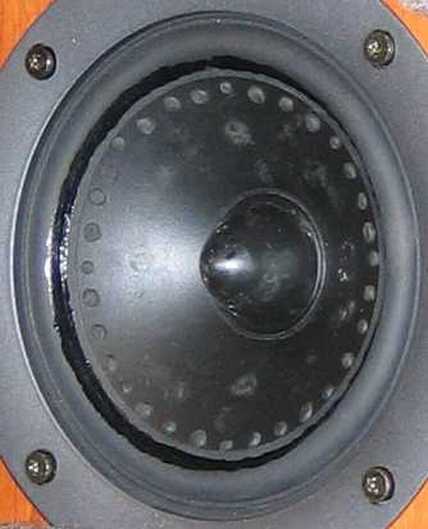
One of the progressively narrowing positionings on the diaphragm:
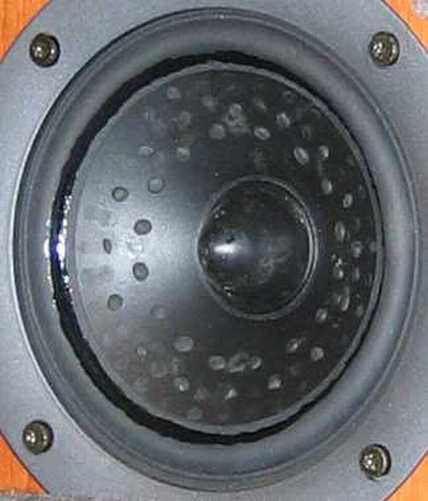
The final position tested (listed as Full Ring #5):
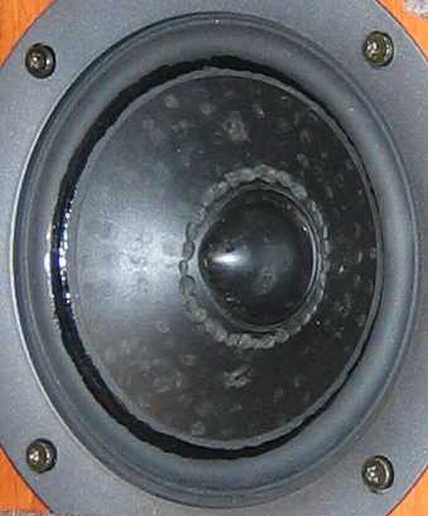
ACTUAL MEASUREMENTS OF EVERY PHOTO SHOWN AT MY WEB PAGE:
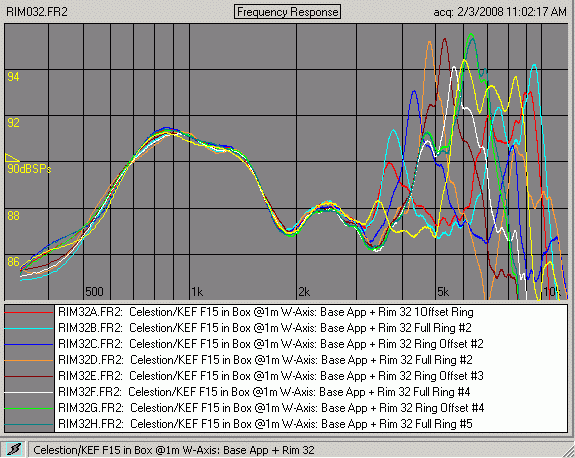
Note that there is little serious affect below 3K, but above 3K it's a wide variety of roller coaster rides. This is on a smallish midwoofer (I hate calling a tiny 2-way a midwoofer). Other drivers will have widely varying results from this.
Now either there is a desire to discuss what happens with added mass/damping (and some very limited local stiffening, I'm sure) and its location or there is no desire to do much other than espouse one's opinions on what occurs (not directed at you MisterTwister).
For those interested, the page is here.
Dave
Last edited:
Full ring #2 is maybe the most interesting to me due to the nature of the response, big peak followed by a major dip, and then a return. Perhaps signifying a transition point where the cone's surface may perhaps, maybe, altered in terms of staying "together" in phase, or something along those lines... pure speculation of course.
_-_-bear
What is the yellow graph line in the FR charts of the mods??
_-_-bear
What is the yellow graph line in the FR charts of the mods??
Last edited:
And if this driver is crossed over at, say 2khz, all modifications with added weight become pretty much irrelevant. I recently found out that all my aluminum driver cone treatments were useless.
Twisterspeakers DIY loudspeaker projects: aluminum woofers' cone treatment experiment
dlr, have you tried to take measurements with wool felt placed in front of the driver (covering entire radiating area).
If it's not a metal driver, there should be nice acoustic roll off.
Twisterspeakers DIY loudspeaker projects: aluminum woofers' cone treatment experiment
dlr, have you tried to take measurements with wool felt placed in front of the driver (covering entire radiating area).
If it's not a metal driver, there should be nice acoustic roll off.
Have you looked over that page in its entirety? Earlier I posted the actual final treatment that shows what can be done and it was relatively minimal. No one takes the time to investigate further it seems. My first post of this driver received no comments, the reason I posted more. That first post here, showed just how much improvement can be made in some cases with minimal treatment. Note that this included the first treatment made, a doping treatment of the surround that is very common to this day on a number of very high quality drivers.And if this driver is crossed over at, say 2khz, all modifications with added weight become pretty much irrelevant.
Here is a re-post the measurement. Go to that link or my full page describing in detail the testing that I did.
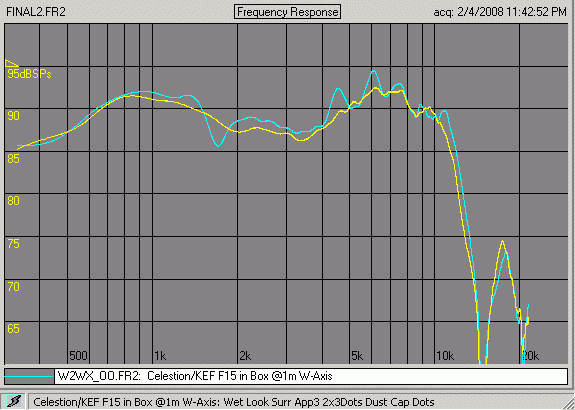
Added weight is not irrelevant, this driver was paired with a tweeter that can't go down to 2K as you suggest. That doesn't have anything to do with what the topic is anyway, we're focusing on effect, not how one may use a driver specifically.
It may be irrelevant on a hard coned driver, they don't respond well, but it is far from irrelevant in all cases.I recently found out that all my aluminum driver cone treatments were useless.
It never crossed my mind.dlr, have you tried to take measurements with wool felt placed in front of the driver (covering entire radiating area).
If it's not a metal driver, there should be nice acoustic roll off.
Dave
As I indicated in the post above, it is from the configuration in the first photo. It's the way that Praxis displays multiple curves. The primary curve, shown at the very bottom of the graph, is yellow. The additional curves are listed in the section at the bottom.What is the yellow graph line in the FR charts of the mods??
Dave
Have you looked over that page in its entirety? Earlier I posted the actual final treatment that shows what can be done and it was relatively minimal. No one takes the time to investigate further it seems. My first post of this driver received no comments, the reason I posted more. That first post here, showed just how much improvement can be made in some cases with minimal treatment. Note that this included the first treatment made, a doping treatment of the surround that is very common to this day on a number of very high quality drivers.
Fear not, Dave, there are people watching. I did visit your page with interest. I for one just don't have anything intelligent to add. Yet. Much of the technical details go over my head, so I don't often have anything worthwhile to add. But I'm learning.
If, as you say, enabl simply amounts to mass added, then the case is closed in terms of mechanism. But as you seem to point out, the change seems quite limited and not something to write 1000s of posts about. I continue to watch (and may someday try it) because of the definitive comments of "believers." It may well be placebo, but that null hypothesis could be reasonably disproven by double blind tests, which noone (from either side) seems to want to do.
Thanks, my reference is to those active in the discussion who seem reluctant to respond to tests and measurements, especially when someone makes a post with comments on drivers modified precisely as directed (not mine for that case). Two simple facts stand out as the most likely reasons, the perceived change was the opposite of what is "expected" and the measurements taken were counter to all claims of significant improvement. This garners total silence. But let someone use toothpaste on a driver and it does wonders with effusive praise for the efforts.Fear not, Dave, there are people watching. I did visit your page with interest. I for one just don't have anything intelligent to add. Yet. Much of the technical details go over my head, so I don't often have anything worthwhile to add. But I'm learning.
If, as you say, enabl simply amounts to mass added, then the case is closed in terms of mechanism. But as you seem to point out, the change seems quite limited and not something to write 1000s of posts about. I continue to watch (and may someday try it) because of the definitive comments of "believers." It may well be placebo, but that null hypothesis could be reasonably disproven by double blind tests, which noone (from either side) seems to want to do.
My tests were methodical and fully documented before and after, as were John's. Mine were not the prescribed pattern, it was just something I had coincidentally just started to test at that time, but the facts show that a specific pattern is not required for significant improvement. The problem is that those who prescribe the specific pattern have absolutely zero to present to show the objective changes that reportedly occur, though it would a simple matter. It seems to be a case of the unknown allows continued effusive praise that a good set of measurements would clarify, but possibly derail, since as was reported in at least one case, the improvement in measured response is not as is claimed will occur.
This is not to say that a driver will not be improved, but that's not a given that it will be perceived that way in all cases. Made to a driver I also don't think it's placebo, I'm sure that the SPL response changes, it almost always does with any form of treatment on a driver. I prefer to leave the issue of immobile objects out. A change occurs to a patterned driver, but there is little of anything provided to document it adequately other than what is claimed to be heard.
Dave
- Status
- This old topic is closed. If you want to reopen this topic, contact a moderator using the "Report Post" button.
- Home
- Loudspeakers
- Multi-Way
- EnABL - Technical discussion